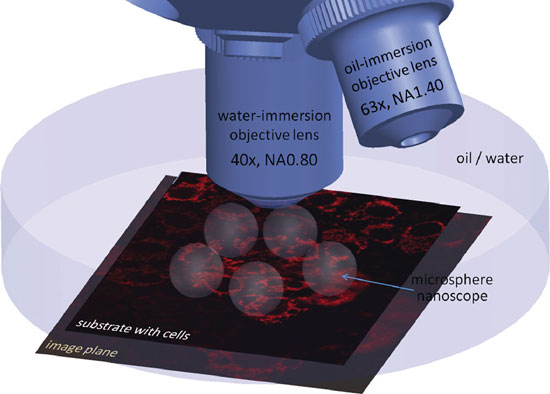| Posted: Jan 07, 2014 | |
Microsphere nanoscope enables super-resolution biological microscopy |
|
| (Nanowerk Spotlight) A conventional optical microscope equipped with an oil immersion objective can resolve objects no smaller than about 200 nanometers – a restriction known as the diffraction limit. The diffraction limit, which typically is half the width of the wavelength of light (λ) being used to view the specimen, represents the fundamental limit of optical imaging resolution. | |
| Breaking this limit is possible by very sophisticated techniques and costly instrumentation. Now, though, researchers in Switzerland have found that when putting a transparent dielectric particle on top of an object with nanoscale features, details of that object with a size corresponding to ∼λ/7 can be resolved using a conventional microscope objective. | |
| "We achieved super-resolution imaging of nanostructures with sub-diffraction feature sizes by using a microsphere nanoscope in combination with a conventional water or oil immersion objective," Martin Gijs, a professor at Ecole Polytechnique Fédérale de Lausanne (EPFL), tells Nanowerk. "Our fluorescence experiments performed in water show that an object with a size as small as one fourth of the diffraction limit can be quantitatively determined, while a 5.4 × magnification of the image is obtained." | |
| Reporting their findings in the December 19, 2013 online edition of Small("Super-Resolution Biological Microscopy Using Virtual Imaging by a Microsphere Nanoscope"), Gijs and his team demonstrated the potential of the technique by resolving the structure of fluorescently stained centrioles, mitochondria, chromosomes, and study the effect of doxycycline treatment on mitochondrial encoded protein expression in a mouse liver cell line. | |
| For their technique, the team used transparent barium titanate glass microspheres that are simply put on top of an object that is immersed in liquid medium. Putting particles (60 µm microspheres) onto an object of interest gives access to nanometric details (down to 100 nm in water) of it and allows easy observation of the image via a conventional microscope objective. | |
| "These particles are easily available commercially and at virtual no cost," says Gijs. "The super-resolution feature of the particle is associated with the existence of a so-called photonic nanojet that emerges from the bottom of such a particle, depending on appropriate choice of the particle size and the refractive index, when the particle is illuminated from the top." | |
 |
|
| Schematic of the microsphere nanoscope. Transparent glass microspheres are located on top of cells and project near-field optical information into the far-field, generating magnified virtual images that are observable by a classical microscope objective. The microspheres can resolve sub-diffraction features and act as superlenses in water or oil. (Reprinted with permission from Wiley-VCH Verlag) | |
| While this optical phenomenon has been known and demonstrated for controlled nanostructures, the EPFL team provides first results on the imaging of biological objects such as centrioles, mitochondria, and chromosomes. | |
| This technique effectively converts a standard laboratory microscope to an instrument with super-resolution capability without extra cost. | |
| Gijs points out that the demonstrated fluorescent superresolution microscopy in water indicates that the technique could be extremely interesting for life science applications. | |
| "We think that in future, due to the straightforwardness of our approach, microspheres will provide a robust and versatile tool that can be used to image with a conventional microscope a variety of biological objects such as viruses, nucleic acids, and functional organelles in living cells," he concludes. | |
 By
Michael
Berger
– Michael is author of three books by the Royal Society of Chemistry:
Nano-Society: Pushing the Boundaries of Technology,
Nanotechnology: The Future is Tiny, and
Nanoengineering: The Skills and Tools Making Technology Invisible
Copyright ©
Nanowerk LLC
By
Michael
Berger
– Michael is author of three books by the Royal Society of Chemistry:
Nano-Society: Pushing the Boundaries of Technology,
Nanotechnology: The Future is Tiny, and
Nanoengineering: The Skills and Tools Making Technology Invisible
Copyright ©
Nanowerk LLC
|
|
|
Become a Spotlight guest author! Join our large and growing group of guest contributors. Have you just published a scientific paper or have other exciting developments to share with the nanotechnology community? Here is how to publish on nanowerk.com. |
|
